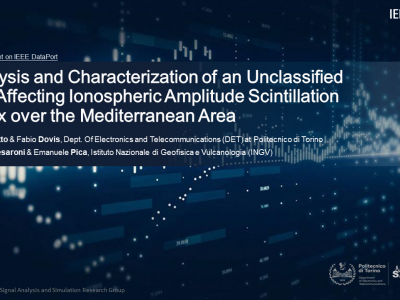Digital signal processing
Radio Frequency (RF) signals transmitted by Global Navigation Satellite Systems (GNSS) are exploited as signals of opportunity in many scientific activities, ranging from sensing waterways and humidity of the terrain to the monitoring of the ionosphere. The latter can be pursued by processing the GNSS signals through dedicated ground-based monitoring equipment, such as the GNSS Ionospheric Scintillation and Total Electron Content Monitoring (GISTM) receivers.
- Categories:
 231 Views
231 Views
This dataset contains trained weights to predict ECG abnormalities.
- Categories:
 54 Views
54 ViewsInterference signals degrade the performance of a global navigation satellite system (GNSS) receiver. Detection and classification of these interference signals allow better situational awareness and facilitate appropriate countermeasures. However, classification is challenging and processing-intensive, especially in severe multipath environments. This dataset is the result of a proposal for a low-resource interference detection and classification approach that combines conventional statistical signal processing approaches with machine learning (ML).
- Categories:
 469 Views
469 ViewsMotion analysis forms a very important research topic with a general mathematical background and applications in different areas including engineering, robotics, and neurology. This paper presents the use of the global navigation satellite system (GNSS) for detection and recording of the moving body position and the simultaneous acquisition of signals from further sensors. The application is related to monitoring of physical activity and the use of wearable sensors of the heart rate and acceleration during different motion patterns.
- Categories:
 238 Views
238 Views
data
- Categories:
 59 Views
59 Views
We propose an algorithm based on linear prediction that can perform both the lossless and near-lossless compression of RF signals. The proposed algorithm is coupled with two signal detection methods to determine the presence of relevant signals and apply varying levels of loss as needed. The first method uses spectrum sensing techniques, while the second one takes advantage of the error computed in each iteration of the Levinson-Durbin algorithm. These algorithms have been integrated as a new pre-processing stage into FAPEC, a data compressor first designed for space missions.
- Categories:
 580 Views
580 Views
The drawback of inter-subcarrier interference in OFDM systems makes the channel estimation and signal detection performance of OFDM systems with few pilots and short cyclic prefixes (CP) poor. Thus, we use deep learning to assist OFDM in recovering nonlinearly distorted transmission data. Specifically, we use a self-normalizing network (SNN) for channel estimation, combined with a convolutional neural network (CNN) and a bidirectional gated recurrent unit (BiGRU) for signal detection, thus proposing a novel SNN-CNN-BiGRU network structure (SCBiGNet).
- Categories:
 232 Views
232 Views
This dataset provides data support for manuscripts that will be submitted soon.
- Categories:
 54 Views
54 ViewsIn this dataset, based on a beam sweeping experiment in the 60 GHz band in an indoor environment, we provide the acquired IQ data samples (containing the announced TX antenna weighting vectors (AWV) index as information) for the given RX AWV index, location, and carrier frequency. We also include the information obtained after processing the PPDU in IQ data.
- Categories:
 929 Views
929 Views



